Fractal Evolution Characteristics of Isolation Layers in a Submarine Gold Mine: A Case Study
Abstract
:1. Introduction
2. Fractal Theory of Fractures
2.1. Fractal Dimension of Fractures in Rock
2.2. Estimation of the Height of the Isolation Layer through Correlation Dimension
- Calculate the distance between two adjacent phase points of xi and xj (I, j, …, N, ):
- b.
- Given any critical distance r (r > 0), the probability that the distance between two phase points is less than r is calculated as
- c.
- The correlation vector is the vector whose distance from the phase point is less than r. By selecting the value of r within a specified range, the correlation dimension of the system can be defined as
3. Experiments in Undersea Chamber Mining
3.1. Similarity Simulation Test Platform for Undersea Mining
3.2. Estimation of the Isolation Layer Thickness of the Similar Model
3.3. Fracture Evolution of the Isolation Layer under Pressure and Seepage Coupling
4. Modeling the Mining of Isolation Layers Using the Bonded Block Model
4.1. Rock Mass Parameter Calibration of the Bonded Block Model
4.2. Model Setup
4.3. Boundary Conditions and Initial Stress
5. Numerical Simulation Results and Discussion
5.1. Deformation of the Isolation Layer with Excavation
5.2. Fractal Evolution Characteristics of Rock Fractures
5.3. Fracture Flow Characteristics of the Mining Area
6. Field Investigation and Verification
6.1. Observation Hole Experiment Method Verification
6.2. Settlement Monitoring Method Verification
7. Conclusions
- (1)
- The results obtained through the similar test model align with the safe thickness determined by the thickness–span ratio. Acoustic emission findings indicate that damage in the model generally propagates from the central top to both sides.
- (2)
- The discrete medium mechanics calculations revealed two critical fractal dimensions for the surrounding rock during isolation layer excavation: one at 1.5 and the other at 1.70.
- (3)
- Field investigations demonstrated that the fractal dimension of fractures in the midsection at −155 m corresponds closely with the calculations from 3DEC. This suggests that determining the safe thickness of offshore isolation layers based on discrete medium mechanics is more accurate and rational. Thus, 3DEC can be effectively utilized for predicting the safety isolation layer’s thickness in offshore mining.
- (4)
- In scenarios where the fracture fractal dimension is unknown, the time series correlation dimension of displacement monitoring can serve as a crucial criterion for assessing the failure or stability of the isolation layer, proving invaluable in engineering applications.
Author Contributions
Funding
Data Availability Statement
Conflicts of Interest
References
- Ma, D.; Li, Q.; Cai, K.; Zhang, J.; Li, Z.; Hou, W.; Sun, Q.; Li, M.; Du, F. Understanding water inrush hazard of weak geological structure in deep mine engineering: A seepage-induced erosion model considering tortuosity. J. Cent. South Univ. 2023, 30, 517–529. [Google Scholar] [CrossRef]
- Ma, D.; Duan, H.; Zhang, J.; Liu, X.; Li, Z. Numerical simulation of water–silt inrush hazard of fault rock: A three-phase flow model. Rock Mech. Rock Eng. 2022, 55, 5163–5182. [Google Scholar] [CrossRef]
- Liu, Z.; Dang, W.; He, X. Undersea safety mining of the large gold deposit in Xinnli District of Sanshandao Gold Mine. Int. J. Miner. Metall. Mater. 2012, 19, 574–583. [Google Scholar] [CrossRef]
- Wang, L.; Chen, J.; Qiao, Z.; Yang, J.; Liu, W. Tribological behaviors of in situ TiB2 ceramic reinforced TiAl-based composites under sea water environment. Ceram. Int. 2017, 43, 4314–4323. [Google Scholar] [CrossRef]
- Ma, D.; Duan, H.; Zhang, J.; Bai, H. A state-of-the-art review on rock seepage mechanism of water inrush disaster in coal mines. Int. J. Coal Sci. Technol. 2022, 9, 50. [Google Scholar] [CrossRef]
- Peng, K.; Li, X.; Wan, C.; Peng, S.; Zhao, G. Safe mining technology of undersea metal mine. Trans. Nonferrous Met. Soc. China 2012, 22, 740–746. [Google Scholar] [CrossRef]
- Zhao, B.; Wang, J. Study on interval rupture mechanism and support optimization of layered roof. Eng. Fail. Anal. 2022, 141, 106690. [Google Scholar] [CrossRef]
- Yang, J.; Liu, C.; Yu, B.; Wu, F. The effect of a multi-gob, pier-type roof structure on coal pillar load-bearing capacity and stress distribution. Bull. Eng. Geol. Environ. 2015, 74, 1267–1273. [Google Scholar] [CrossRef]
- Zhang, H.; Song, W.; Fu, J. Analysis of large-span goaf roof instability critical parameters and stability. J. Min. Saf. Eng. 2014, 31, 66. (In Chinese) [Google Scholar]
- Liu, Z.; Lu, T.; Li, X.; Li, X.; Huai, Z.; Wang, S. Construction of reasonable pillar group for undersea mining in metal mine. Trans. Nonferrous Met. Soc. China 2018, 28, 757–765. [Google Scholar] [CrossRef]
- Li, D.; Zhang, J.; Sun, Y.; Li, G. Evaluation of rockburst hazard in deep coalmines with large protective island coal pillars. Nat. Resour. Res. 2021, 30, 1835–1847. [Google Scholar] [CrossRef]
- Wu, W.; Bai, J.; Wang, X.; Yan, S.; Wu, S. Numerical study of failure mechanisms and control techniques for a gob-side yield pillar in the Sijiazhuang coal mine, China. Rock Mech. Rock Eng. 2019, 52, 1231–1245. [Google Scholar] [CrossRef]
- Miao, X.; Cui, X.; Wang, J.; Xu, J. The height of fractured water-conducting zone in undermined rock strata. Eng. Geol. 2011, 120, 32–39. [Google Scholar] [CrossRef]
- Davies, R.; Mathias, S.; Moss, J.; Hustoft, S.; Newport, L. Hydraulic fractures: How far can they go? Mar. Pet. Geol. 2012, 37, 1–6. [Google Scholar] [CrossRef]
- Baghbanan, A.; Jing, L. Hydraulic properties of fractured rock masses with correlated fracture length and aperture. Int. J. Rock Mech. Min. Sci. 2007, 44, 704–719. [Google Scholar] [CrossRef]
- Castro-Filgueira, U.; Alejano, L.; Ivars, D. Particle flow code simulation of intact and fissured granitic rock samples. J. Rock Mech. Geotech. Eng. 2020, 12, 960–974. [Google Scholar] [CrossRef]
- Lak, M.; Fatehi, M.; Yarahmadi, A.; Abdollahipour, A. Discrete element modeling of explosion-induced fracture extension in jointed rock masses. J. Min. Environ. 2019, 10, 125–138. [Google Scholar] [CrossRef]
- Ju, Y.; Wang, Y.; Su, C.; Zhang, D.; Ren, Z. Numerical analysis of the dynamic evolution of mining-induced stresses and fractures in multilayered rock strata using continuum-based discrete element methods. Int. J. Rock Mech. Min. Sci. 2019, 113, 191–210. [Google Scholar] [CrossRef]
- Tomac, I.; Gutierrez, M. Micromechanics of hydraulic fracturing and damage in rock based on DEM modeling. Granul. Matter 2020, 22, 56. [Google Scholar] [CrossRef]
- Di, S.; Xu, W.; Wang, W.; Wu, G. Macro-mechanical properties of columnar jointed basaltic rock masses. J. Cent. South Univ. Technol. 2011, 18, 2143–2149. [Google Scholar] [CrossRef]
- Wang, H.; Song, F.; Chen, Y.; Li, T.; Ma, G. Stability analysis of fractured rock masses based on an extended key block theory considering the forces between blocks and block rotation. Tunn. Undergr. Space Technol. 2023, 132, 104895. [Google Scholar] [CrossRef]
- Sinha, S.; Walton, G. A study on Bonded Block Model (BBM) complexity for simulation of laboratory-scale stress-strain behavior in granitic rocks. Comput. Geotech. 2020, 118, 103363. [Google Scholar] [CrossRef]
- Ryvkin, M.; Shraga, R. Fracture toughness of hierarchical self-similar honeycombs. Int. J. Solids Struct. 2018, 152, 151–160. [Google Scholar] [CrossRef]
- Archambault, G.; Rouleau, A.; Daigneault, R.; Flamand, R. Progressive failure of rock masses by a self similar anastomosing process of rupture at all scales and its scale effect on their shear strength. In Scale Effects in Rock Masses 93; CRC Press: Boca Raton, FL, USA, 2020; pp. 133–141. [Google Scholar]
- Zhou, B.; Wei, D.; Ku, Q.; Wang, J.; Zhang, A. Study on the effect of particle morphology on single particle breakage using a combined finite-discrete element method. Comput. Geotech. 2020, 122, 103532. [Google Scholar] [CrossRef]
- Liu, X.; Zeng, Y.; Xia, C.; Liu, H.; Xie, Q.; Zhong, Y. Influence of specimen size on granite fracture characteristics and acoustic emission phenomena under mode I loading conditions. Theor. Appl. Fract. Mech. 2023, 128, 104106. [Google Scholar] [CrossRef]
- Rasmussen, L.; Min, K. Developments to the Bonded Block Modeling technique for Discrete Element simulation of transversely isotropic rocks. Int. J. Rock Mech. Min. Sci. 2023, 170, 105518. [Google Scholar] [CrossRef]
- Sinha, S.; Shirole, D.; Walton, G. Investigation of the micromechanical damage process in a granitic rock using an inelastic bonded block model (BBM). J. Geophys. Res. Solid Earth 2020, 125, e2019JB018844. [Google Scholar] [CrossRef]
- Sui, L.; Yu, J.; Cang, D.; Miao, W.; Wang, H.; Zhang, J. The fractal description model of rock fracture networks characterization. Chaos Solitons Fractals 2019, 129, 71–76. [Google Scholar] [CrossRef]
- Miao, T.; Yu, B.; Duan, Y.; Fang, Q. A fractal analysis of permeability for fractured rocks. Int. J. Heat Mass Transf. 2015, 81, 75–80. [Google Scholar] [CrossRef]
- Bisoi, A.K.; Mishra, J. On calculation of fractal dimension of images. Pattern Recognit. Lett. 2001, 22, 631–637. [Google Scholar] [CrossRef]
- Klinkenberg, B. A review of methods used to determine the fractal dimension of linear features. Math. Geol. 1994, 26, 23–46. [Google Scholar] [CrossRef]
- Foroutan-pour, K.; Dutilleul, P.; Smith, D. Advances in the implementation of the box-counting method of fractal dimension estimation. Appl. Math. Comput. 1999, 105, 195–210. [Google Scholar] [CrossRef]
- Grassberger, P. Grassberger-Procaccia algorithm. Scholarpedia 2007, 2, 3043. [Google Scholar] [CrossRef]
- Camastra, F.; Vinciarelli, A. Intrinsic dimension estimation of data: An approach based on Grassberger–Procaccia’s algorithm. Neural Process. Lett. 2001, 14, 27–34. [Google Scholar] [CrossRef]
- Chen, D.; Li, N.; Wang, E.-Y. Temporal and spatial evolution of acoustic emission and waveform characteristics of specimens with different lithology. J. Geophys. Eng. 2018, 15, 1878–1888. [Google Scholar] [CrossRef]
- Cheng, T.; Wang, L.; Xiao, Y.; He, M.; Wang, T.; Peng, M.; Li, H. Correlational fractal characteristics and damage progression of granite with different grain sizes based on acoustic emission monitoring. Eng. Geol. 2023, 327, 107358. [Google Scholar] [CrossRef]
- Wang, F.F.; Dai, H.H.; Giorgio, I. A numerical comparison of the uniformly valid asymptotic plate equations with a 3D model: Clamped rectangular incompressible elastic plates. Math. Mech. Solids 2022, 27, 1370–1396. [Google Scholar] [CrossRef]

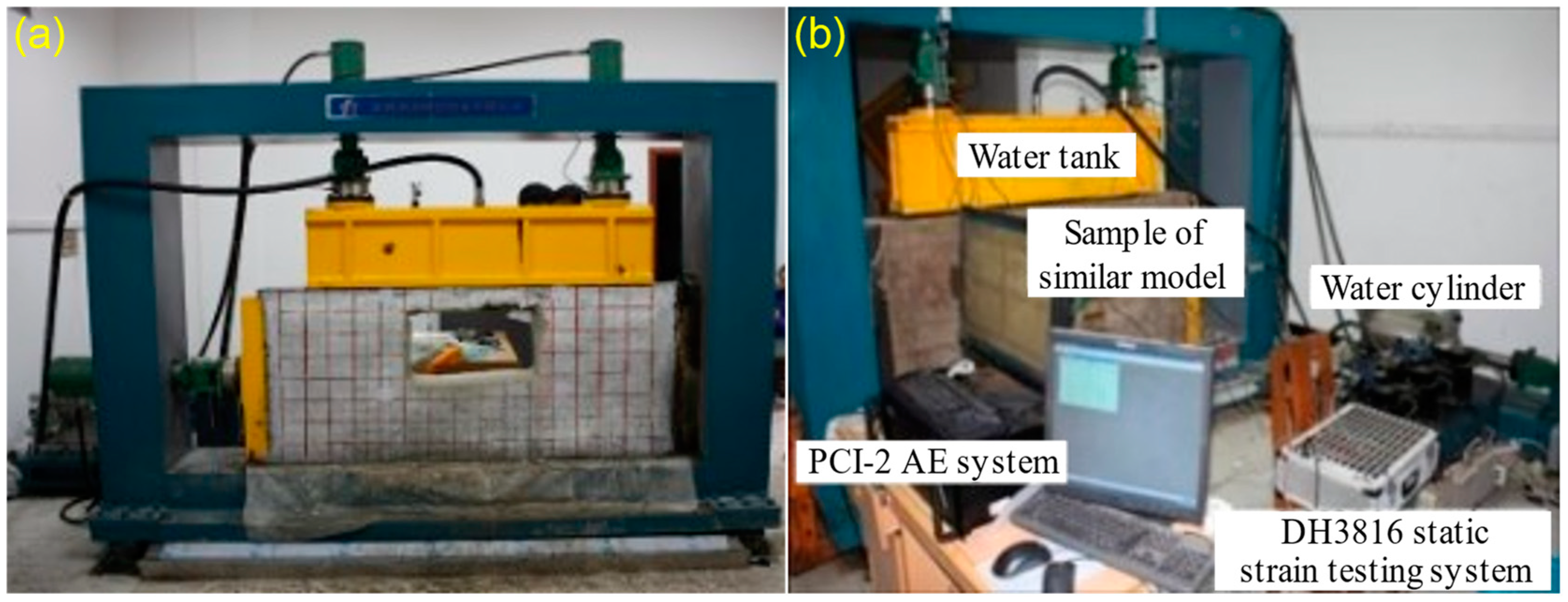

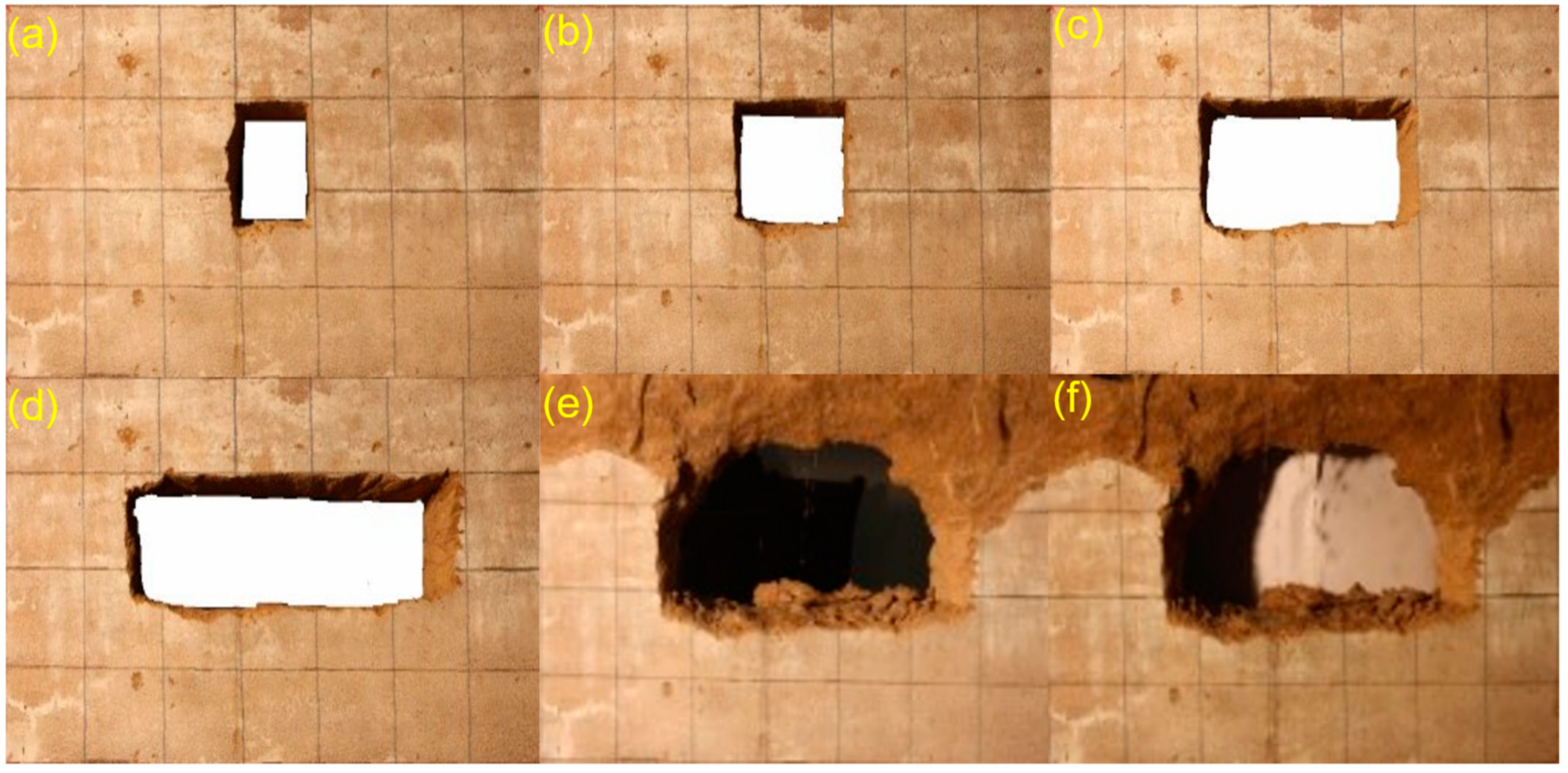
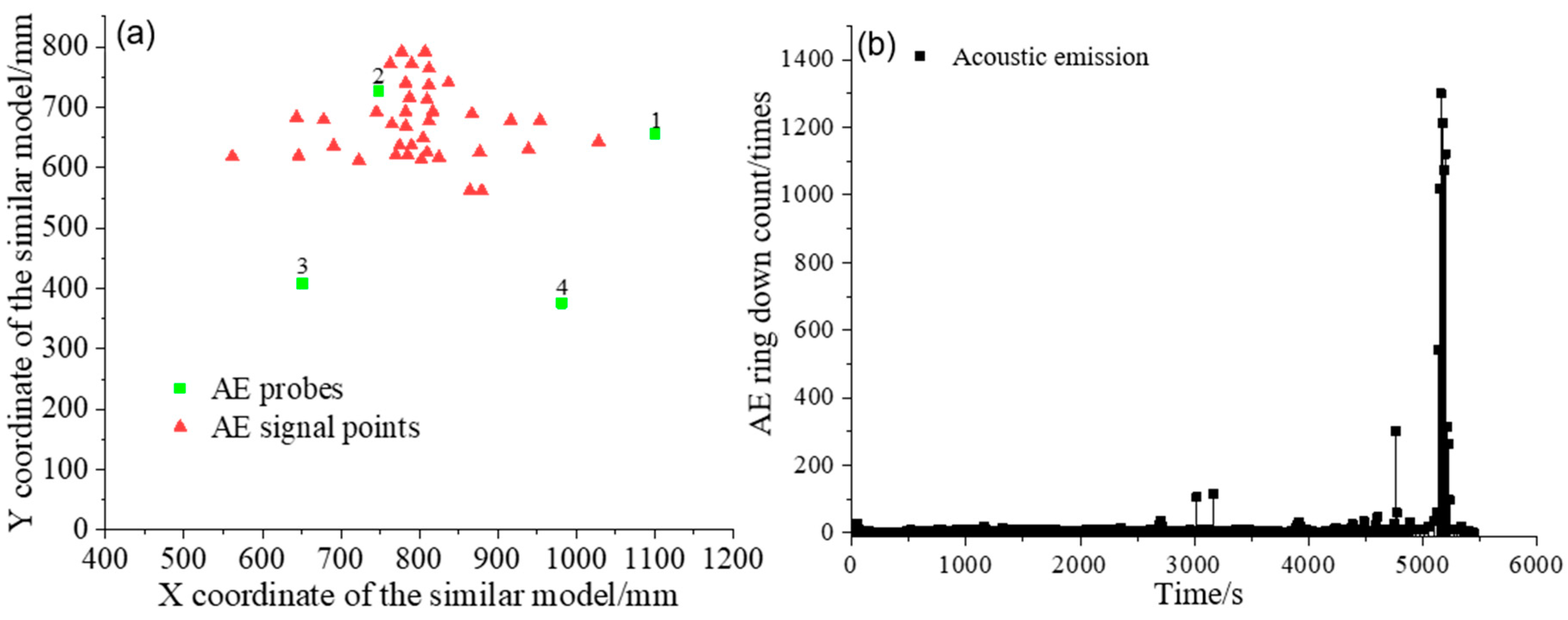
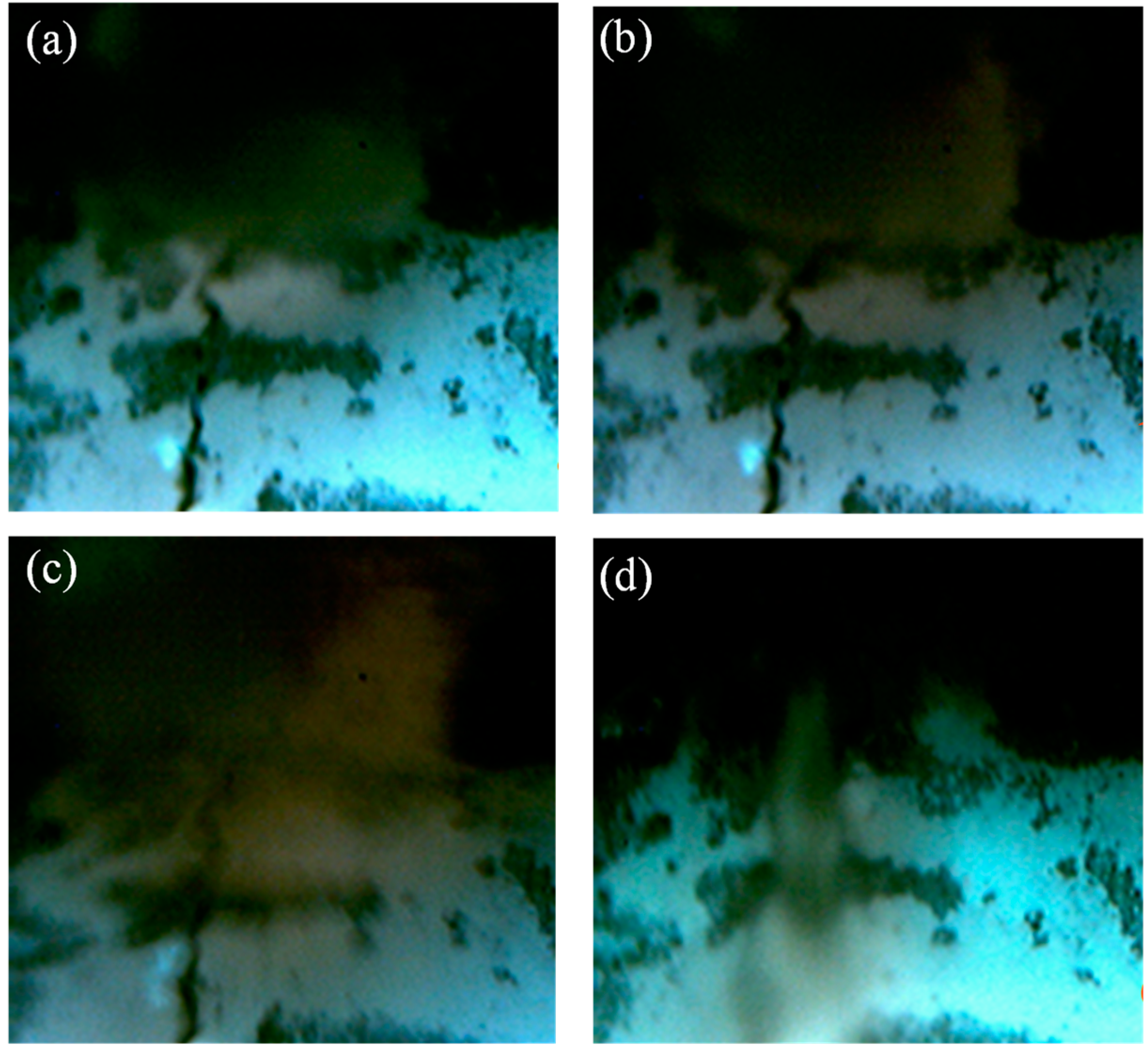
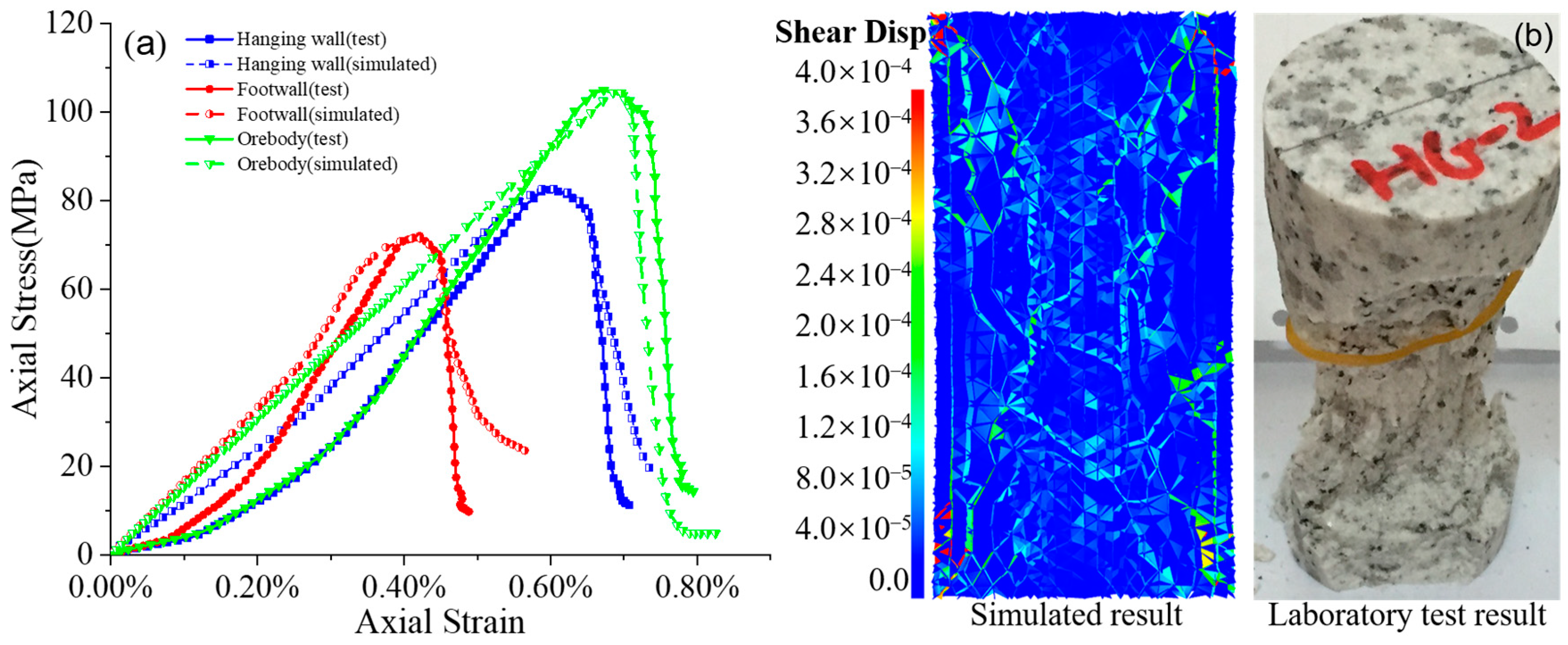
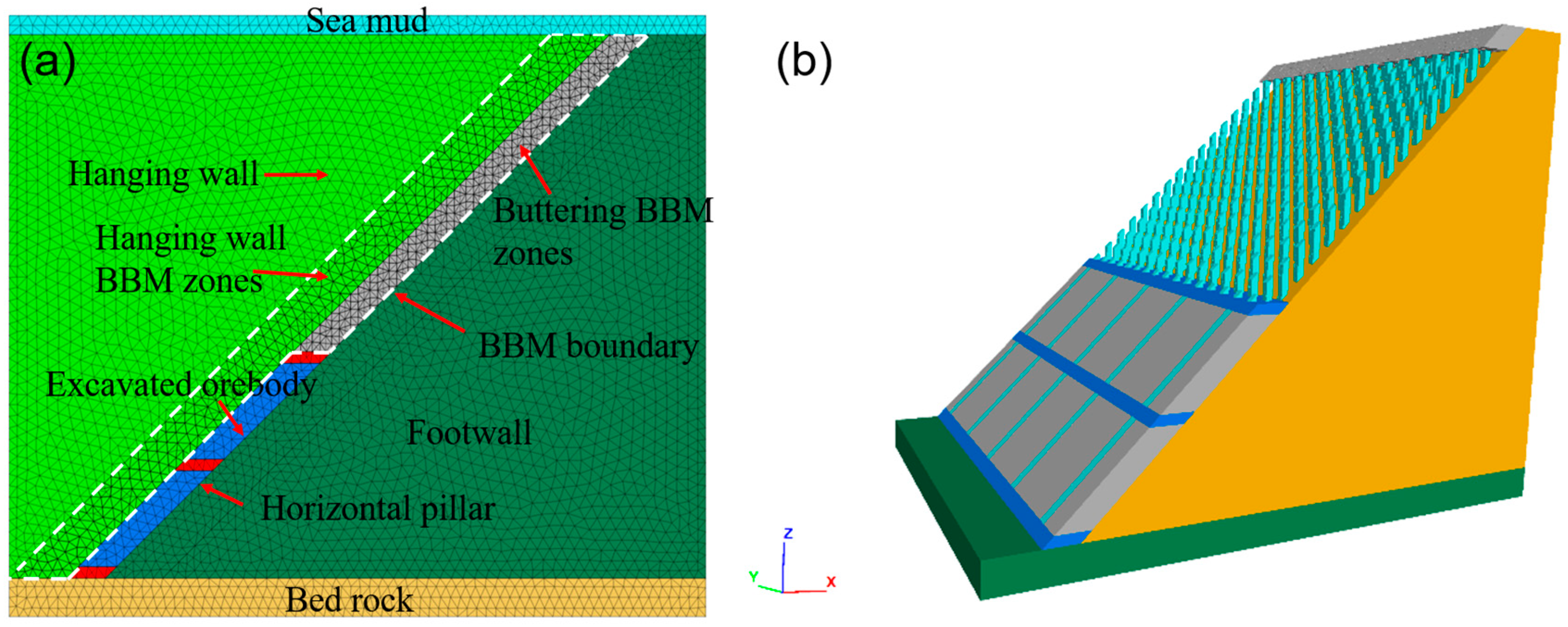

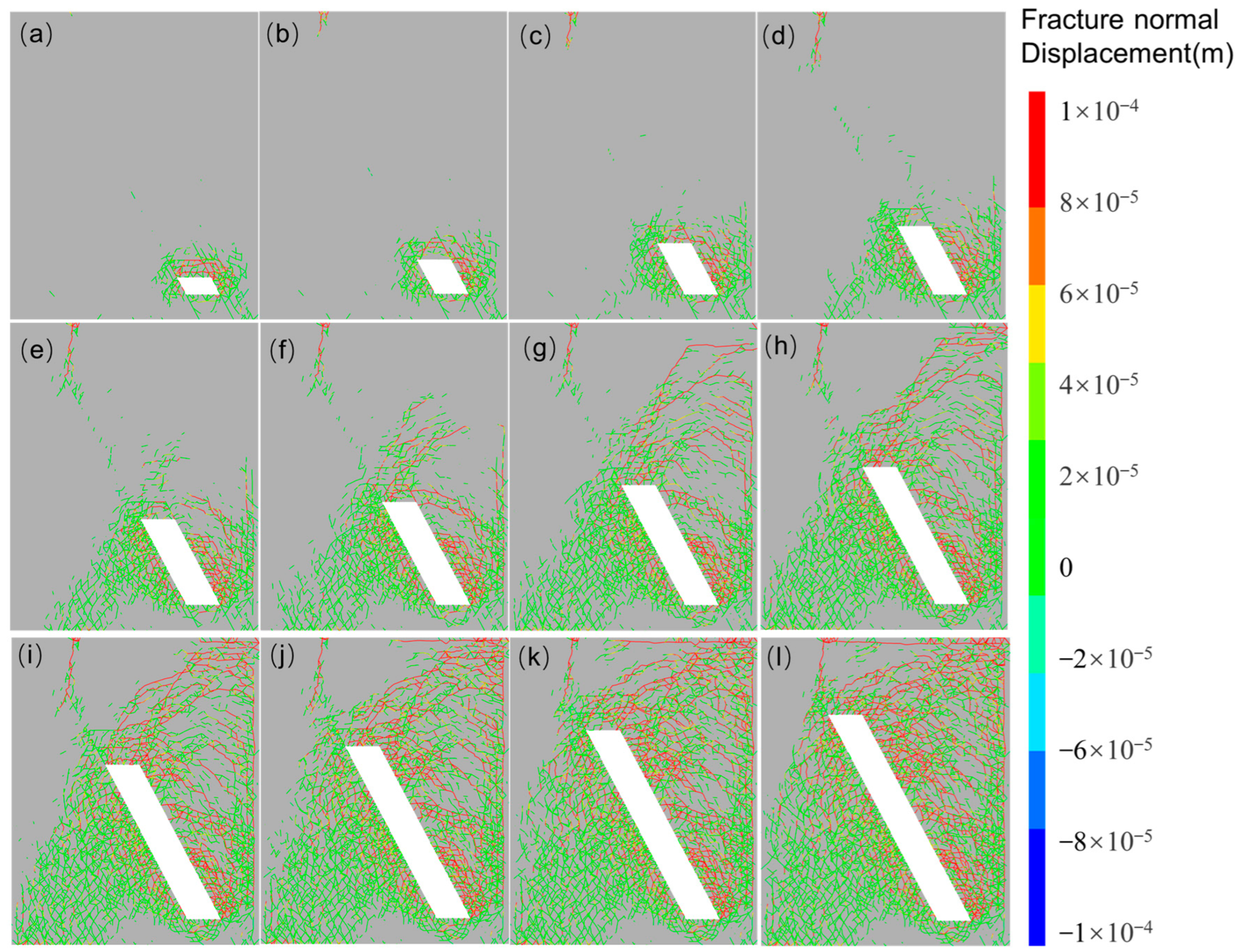

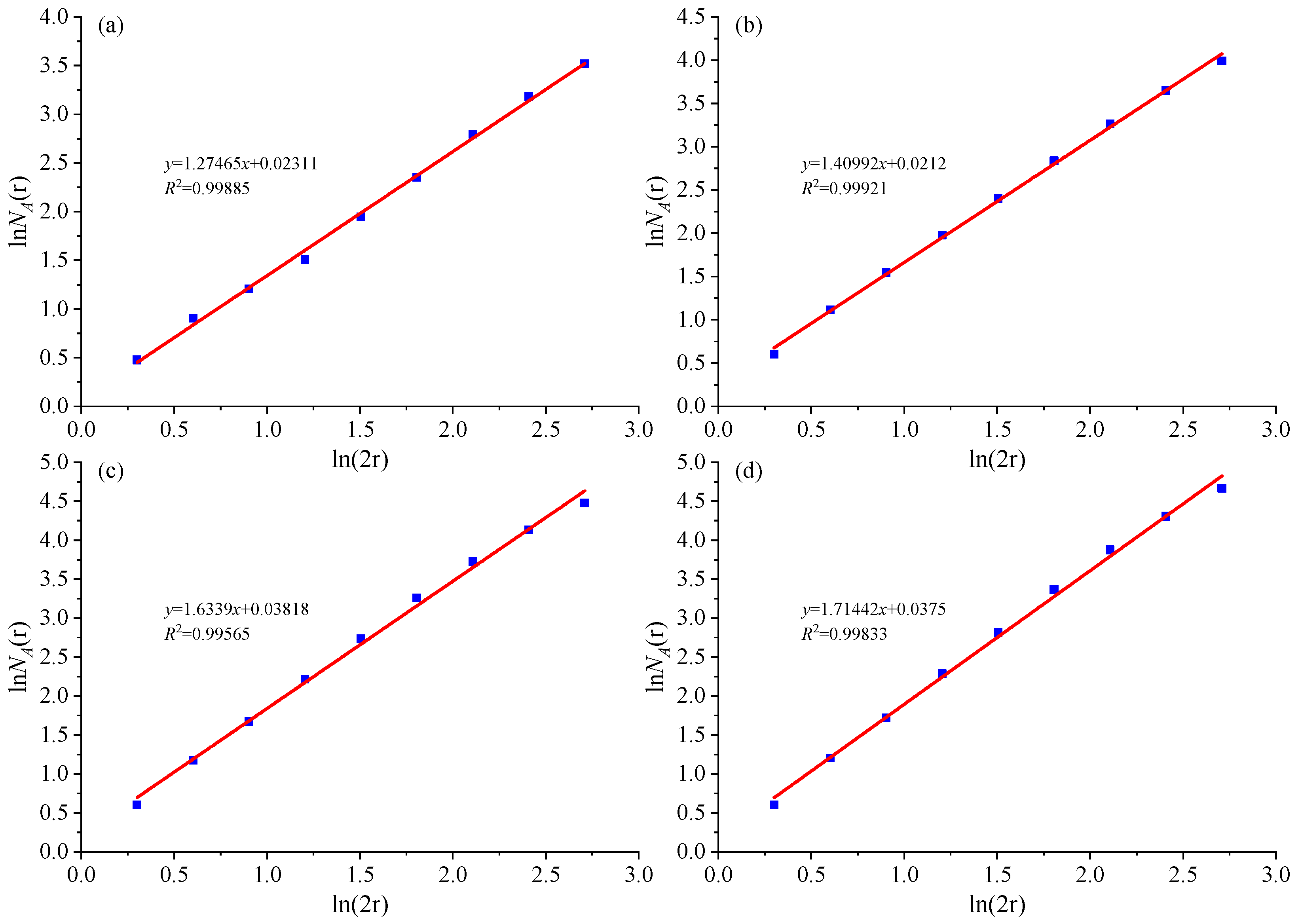
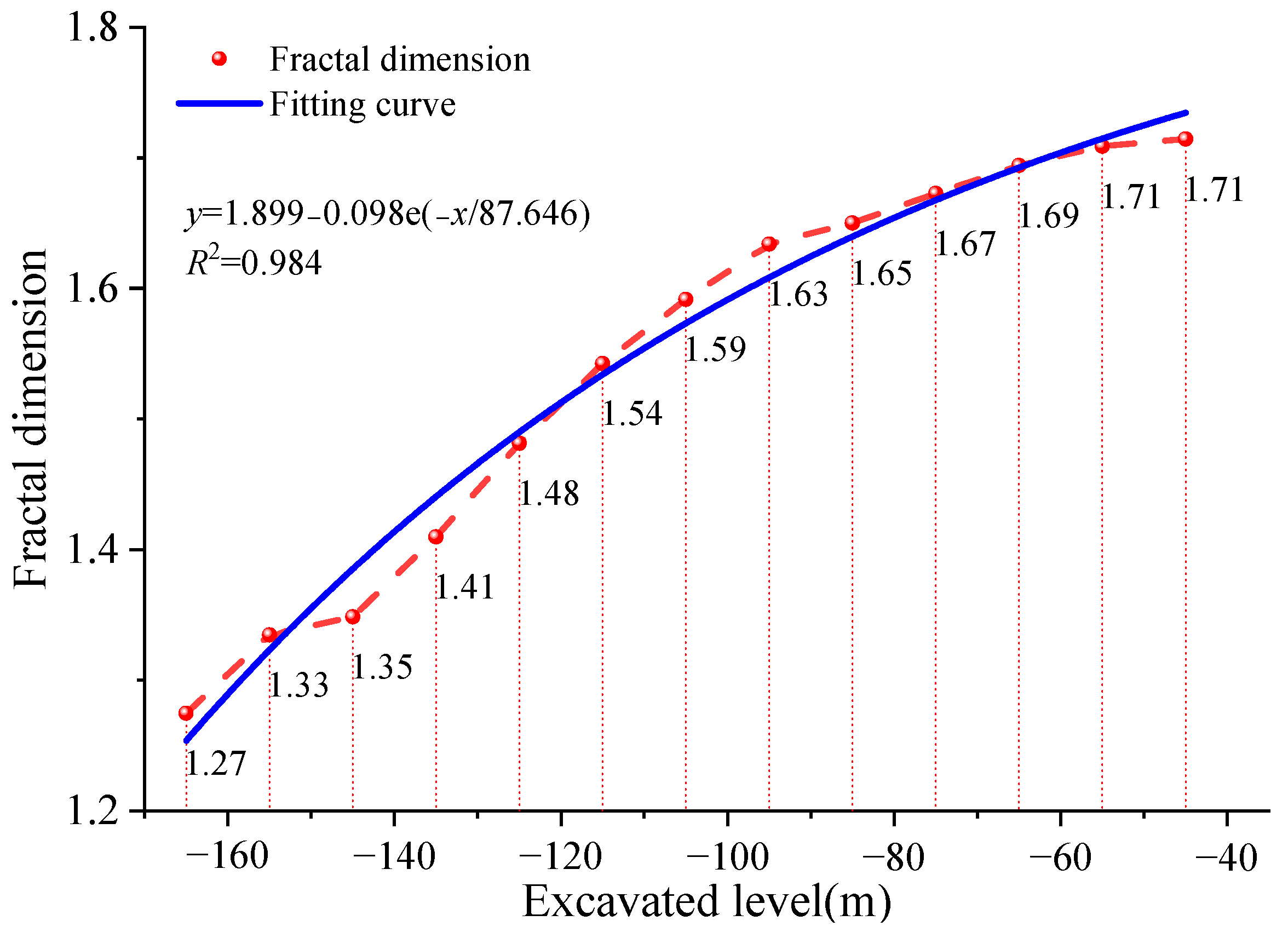
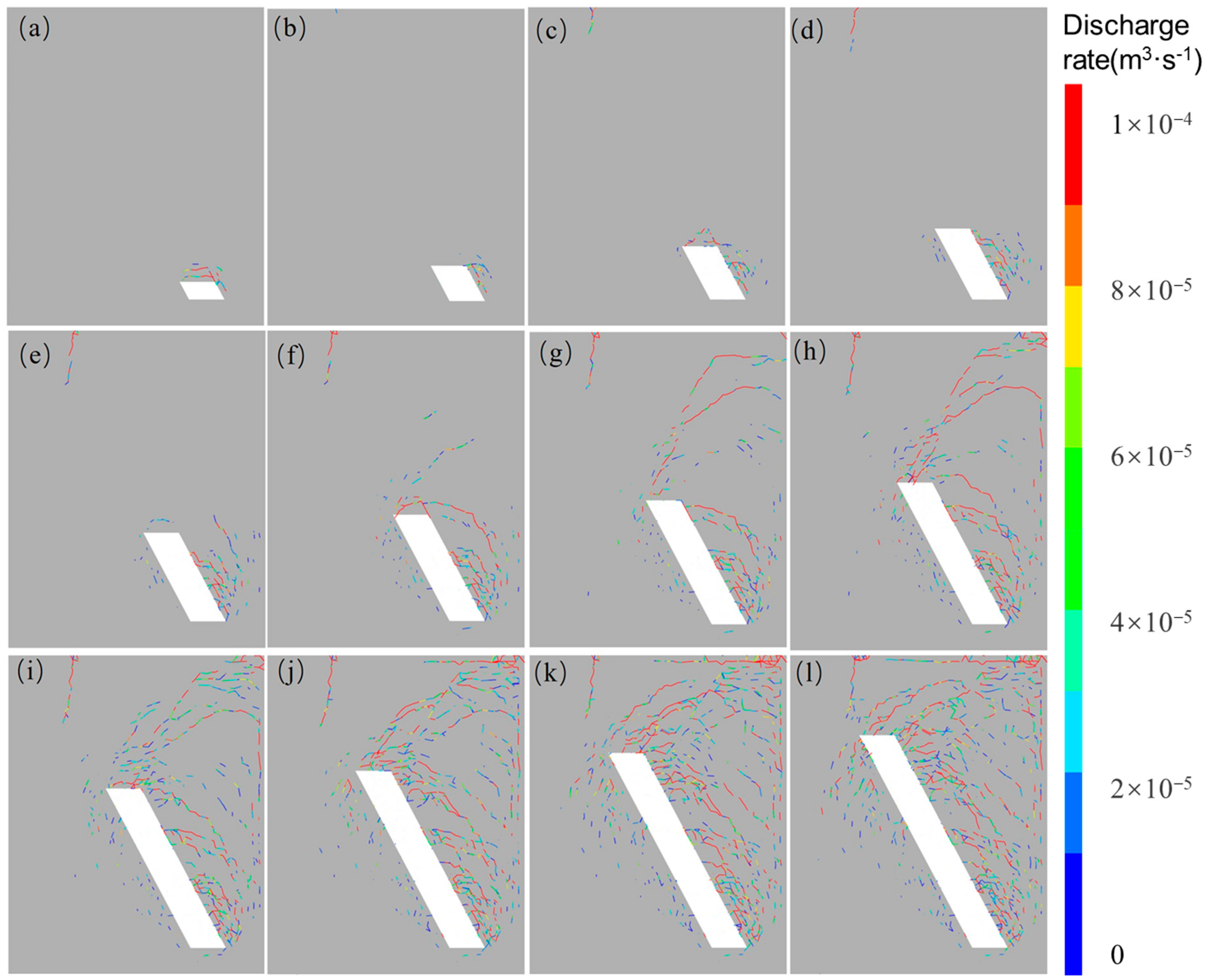
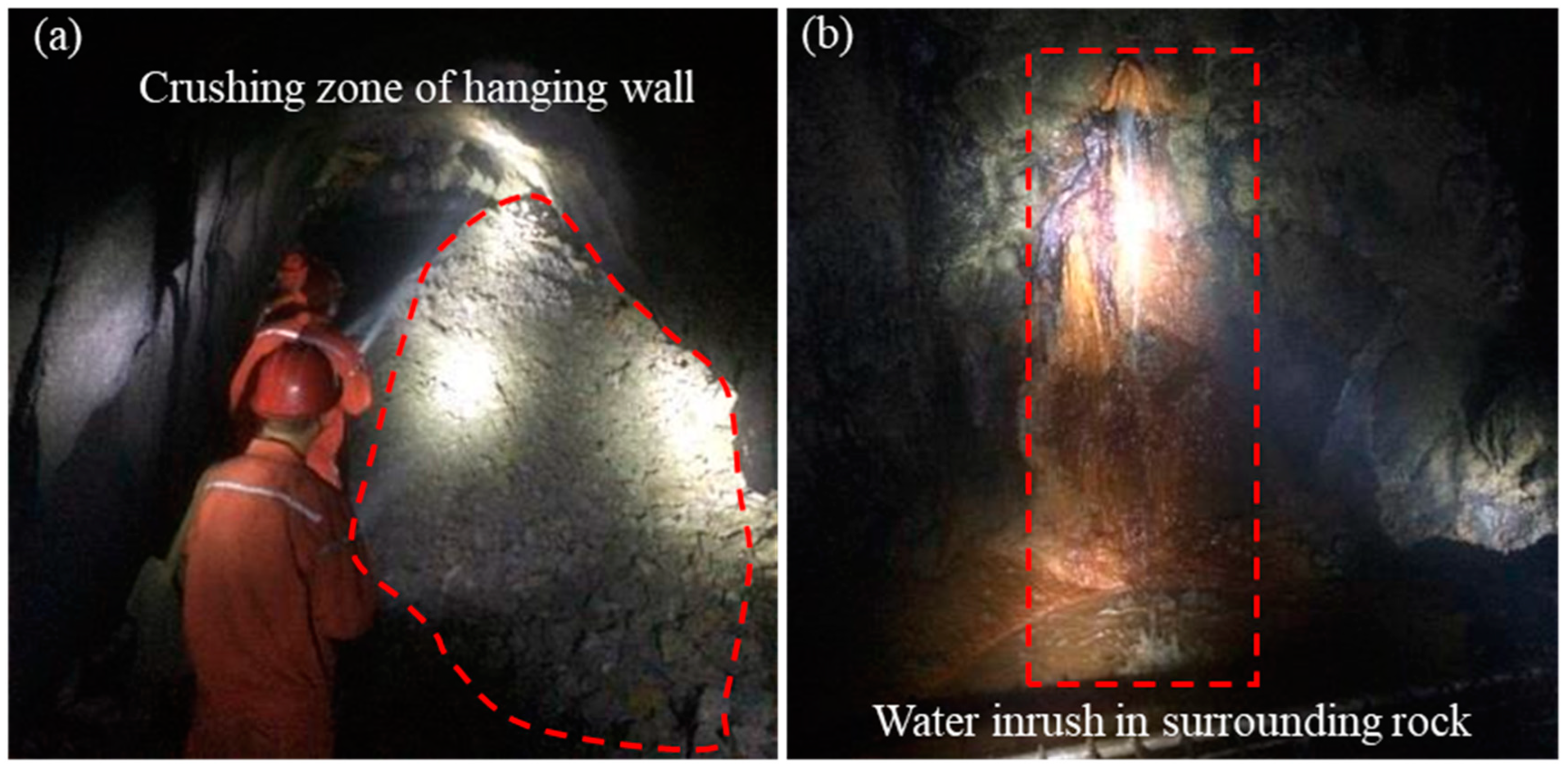
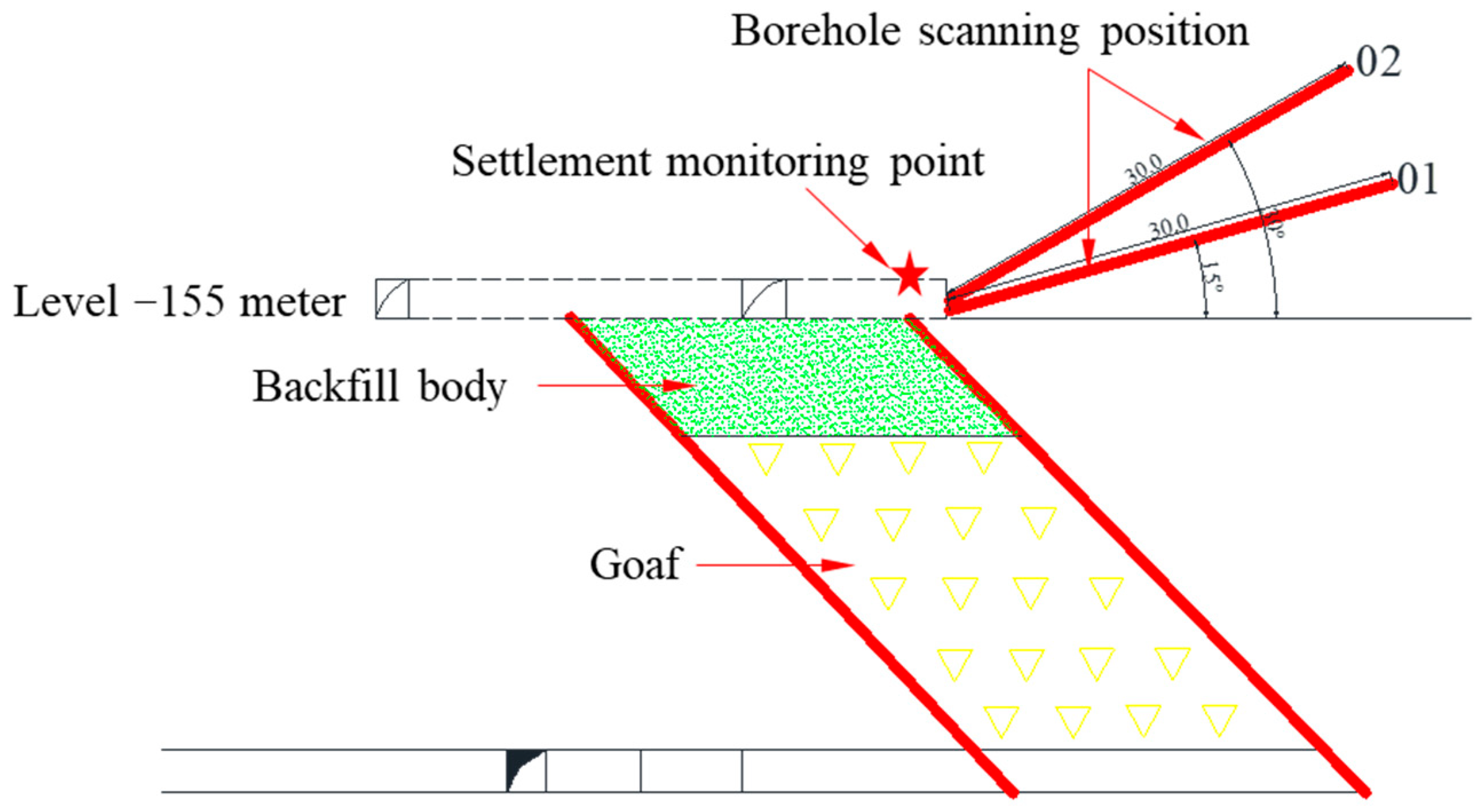

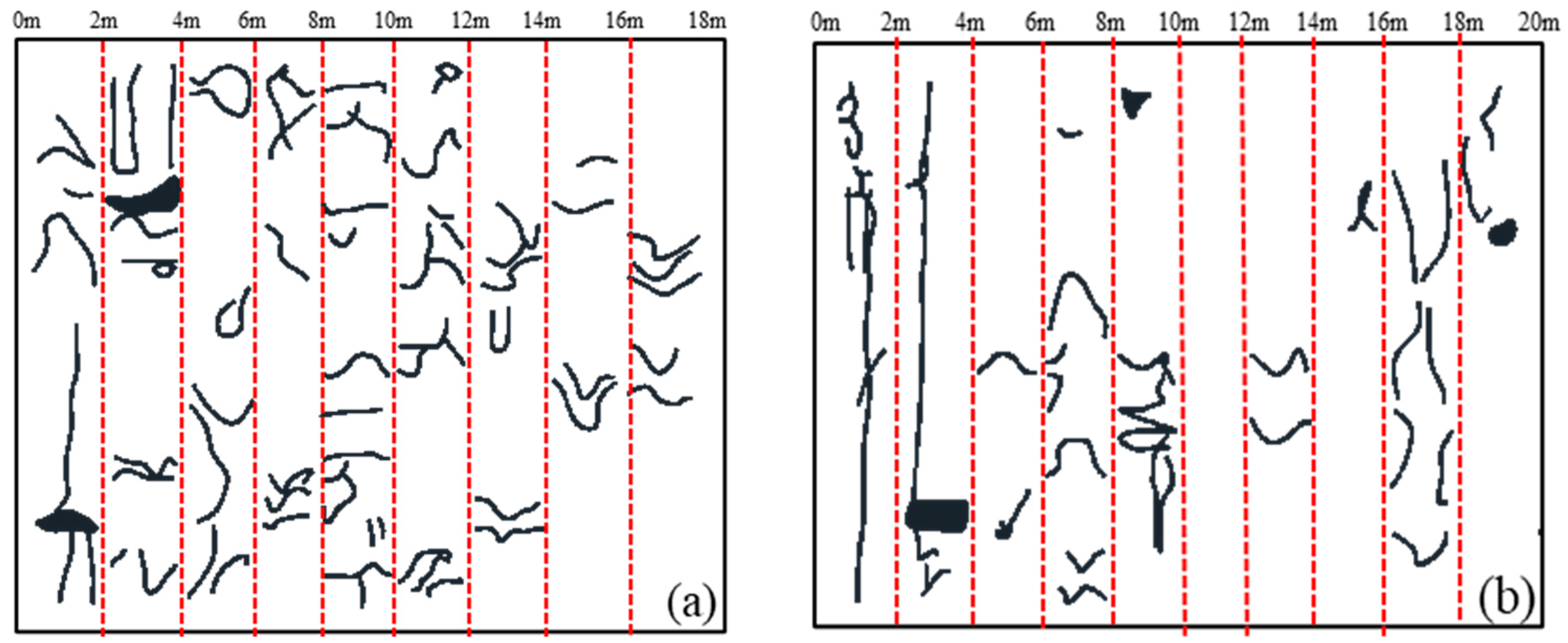
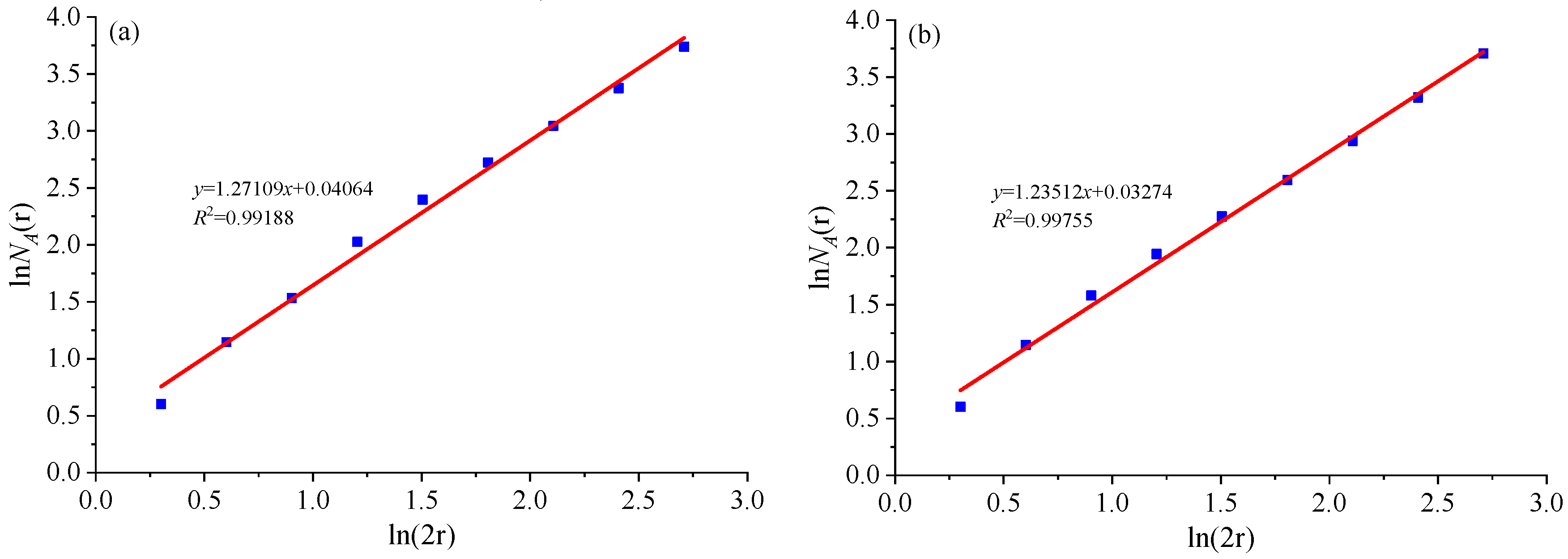


| Lithology | Density (kg·m−3) | Elastic Young’s Modulus, E (GPa) | Poisson’s Ratio | Tensile Strength (MPa) | Cohesion (MPa) | Internal Friction Angle (°) | Uniaxial Compressive Strength (MPa) |
|---|---|---|---|---|---|---|---|
| Hanging wall | 2706 | 13.44 | 0.20 | 3.18 | 5.72 | 30.60 | 82.03 |
| Orebody | 2709 | 15.02 | 0.19 | 3.72 | 6.43 | 32.60 | 102.95 |
| Footwall | 2635 | 17.10 | 0.24 | 4.31 | 5.72 | 36.94 | 72.07 |
| Contact | Normal Stiffness (GPa·m−1) | Shear Stiffness, (GPa·m−1) | Tensile Strength (MPa) | Cohesion (MPa) | Internal Friction Angle (°) |
|---|---|---|---|---|---|
| Hanging wall | 324 | 105 | 4.35 | 12.19 | 29.72 |
| Orebody | 267 | 89 | 4.51 | 12.37 | 29.30 |
| Footwall | 163 | 61.9 | 4.28 | 11.82 | 29.63 |
Disclaimer/Publisher’s Note: The statements, opinions and data contained in all publications are solely those of the individual author(s) and contributor(s) and not of MDPI and/or the editor(s). MDPI and/or the editor(s) disclaim responsibility for any injury to people or property resulting from any ideas, methods, instructions or products referred to in the content. |
© 2024 by the authors. Licensee MDPI, Basel, Switzerland. This article is an open access article distributed under the terms and conditions of the Creative Commons Attribution (CC BY) license (https://creativecommons.org/licenses/by/4.0/).
Share and Cite
Chen, Y.; Li, Z.; Lin, W.; He, Y.; Wang, G.; Ou, R.; Liu, Q. Fractal Evolution Characteristics of Isolation Layers in a Submarine Gold Mine: A Case Study. Minerals 2024, 14, 205. https://doi.org/10.3390/min14020205
Chen Y, Li Z, Lin W, He Y, Wang G, Ou R, Liu Q. Fractal Evolution Characteristics of Isolation Layers in a Submarine Gold Mine: A Case Study. Minerals. 2024; 14(2):205. https://doi.org/10.3390/min14020205
Chicago/Turabian StyleChen, Yin, Zijun Li, Weixing Lin, Yan He, Guoqiang Wang, Renze Ou, and Qi Liu. 2024. "Fractal Evolution Characteristics of Isolation Layers in a Submarine Gold Mine: A Case Study" Minerals 14, no. 2: 205. https://doi.org/10.3390/min14020205





